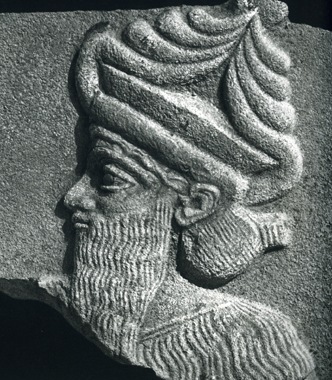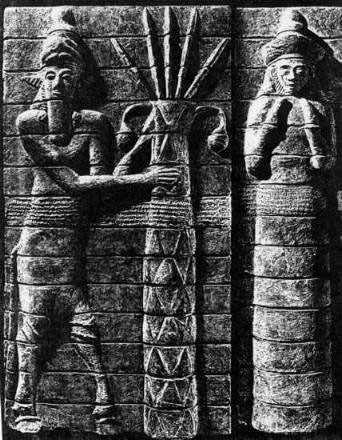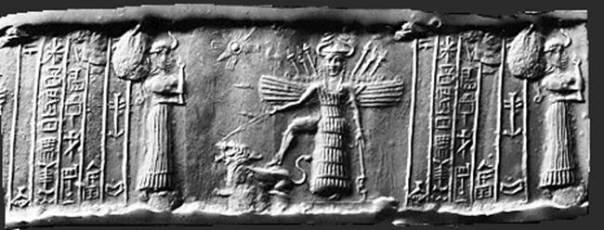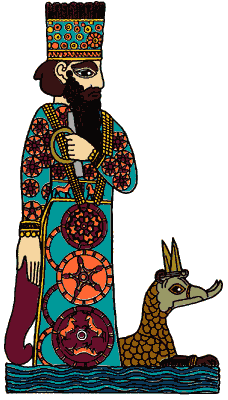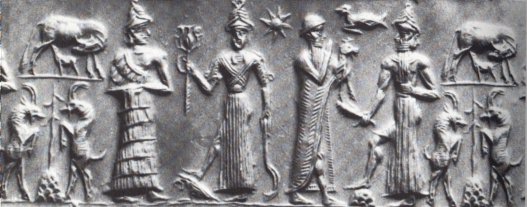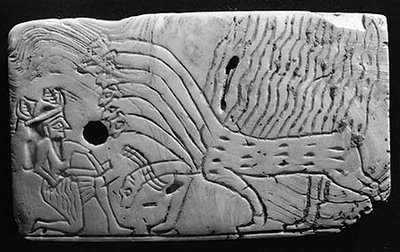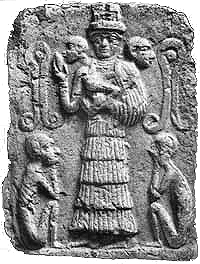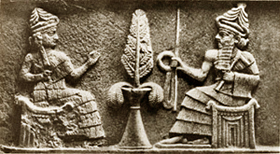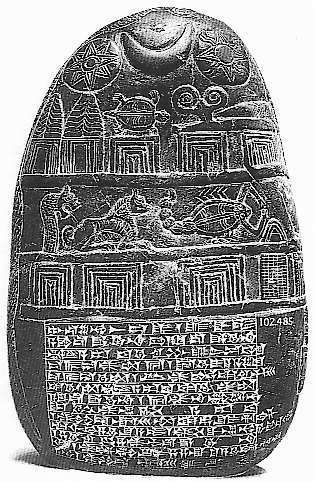..https://reydekish.com/2016/09/07/panteon-de-dioses-sumerios/
El presente artículo ha sido elaborado en base a las siguientes publicaciones de Daniel Marín Arcones: Introducción a la Mitología Mesopotámica, Kudurrus y Cronología Mesopotámica.
La mitología de los pueblos de Mesopotamia es probablemente una de las más interesante a la vez que desconocida de la historia de la humanidad. Es muy complicado realizar un análisis exhaustivo de todos los mitos y leyendas que rodean la rica historia de este rincón del planeta, por lo que a continuación se ofrece solamente una pequeña guía de los dioses y diosas más importantes del panteón mesopotámico que nos servirán para entender mejor la relación de estos pueblos con el cosmos.
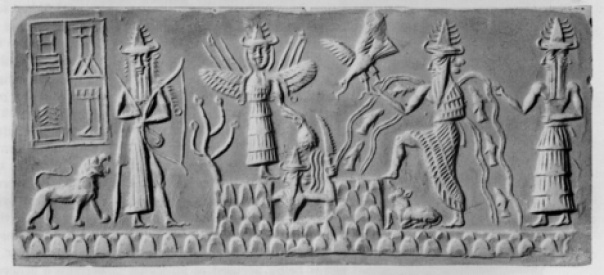
Ninurta con su arco y su león, Inanna-Ishtar, Shamash-Utu (con cuchillo en mano), Ea-Enki y su visir el “dos caras” Isimud-Usmu
Ante todo, hay que tener en cuenta que, al igual que la mayor parte de mitologías, la mesopotámica no es un cuerpo sólido de personajes bien establecidos: el papel de cada dios cambió mucho a lo largo de la historia. Incluso en un mismo periodo de tiempo, una misma divinidad podía ser adorada en una ciudad-estado, y sin embargo ser casi desconocida en otra. Los dioses seguían la suerte de los reinos y ciudades en los que eran adorados: así, cuando Babilonia se convirtió en el reino más poderoso, también su dios principal, Marduk, se transformó en el dios principal, pese a que hasta entonces había sido una divinidad irrelevante. Igualmente cambiantes son las relaciones de parentesco entre dioses.
Pero por encima de todo, la principal referencia de la mitología mesopotámica es la división entre divinidades sumerias y semitas. Efectivamente, los dioses sumerios fueron adaptados posteriormente por los pueblos semitas (acadios primero, babilonios, asirios, arameos y caldeos posteriormente) que fueron llegando a la región, añadiendo éstos personajes propios al acervo mitológico de la zona. Además, hay dioses propios de los pueblos circundantes, ajenos a la tradición sumeria y semita, como las diversas diosas madres (especialmente la diosa Shala) o dioses de la fertilidad y los elementos (Dagan, Adad, etc.).
DIOSES PRINCIPALES
* “Nombre” en babilónico; (“Nombre” en sumerio)
ANU (An): dios del cielo. De hecho, “an” significa precisamente cielo en sumerio. Junto con Enki y Enlil forma la llamada “Tríada Sumeria” de dioses principales. Se supone que en un principio (antes de 2500 AEC) era el dios principal, para luego ser sustituido por Enlil en este papel y luego por los distintos dioses regionales (Marduk, Ashur, etc.). Pese a esto, siempre tuvo un papel preponderante en todos los panteones como demiurgo o dios original del Universo, aunque sus características concretas nunca estuvieron muy definidas.
Astronómicamente, estaba asociado con el “Camino o Sendero de An”, región de la bóveda celeste coincidente con el Ecuador. Posteriormente se definiría dicha región como el espacio entre los dos trópicos. Tenía asociado el número 60, cifra sagrada para los sumerios. Su ideograma en caracteres cuneiformes también servía para describir la palabra “dios”, dingir en sumerio, ilum en acadio. Se le representaba mediante una estrella o, más frecuentemente a partir de la época Cassita, mediante la corona de siete pares de cuernos propia de los grandes dioses. En la tradición babilónica estaba unido a la diosa Antu. El centro de su culto era la antigua ciudad deUruk.
ENLIL: dios supremo del panteón sumerio-acadio, era el dios del cielo, del viento y las tempestades. Se han propuesto dos orígenes para el nombre Enlil. Según el primero vendría del sumerio EN.LÍL, siendo EN: “Señor”, y LÍL: “Tormenta” o “Viento”, por lo que su nombre significaría literalmente, “Señor de la tormenta” o “Señor del viento” o “dios del viento”.
La otra opción, más reciente, indicaría una sumerización de la raíz semita il (Dios), la misma que da origen a los términos El y Alá, significando así dios señor. En la tradición acadia era conocido como Ellil. En el poema de Atrahasis, Enlil intenta destruir a la humanidad en tres oportunidades, molesto por sus hábitos ruidosos. En el último de estos intentos, es Enlil quien ordena arrasar la Tierra con un Diluvio.
Astronómicamente era asociado con el “Camino de Enlil”, región del cielo al norte del ecuador celeste, a veces coincidente con el Trópico de Cáncer. También se le relacionó con las Pléyades (Mul-mul, en sumerio) e inicialmente con el planetaJúpiter, que posteriormente sería asimilado por el dios de Babilonia, Marduk. Su número era el 50. La tradición babilónica lo unía a la diosa Ninlil. Muchos grandes dioses son hijos suyos: Adad, Nergal, Ninurta, Pabilsag o Zababa. Tradicionalmente, el centro de su culto era Nippur, donde estaba el E-kur (en sumerio, “la casa de la montaña”), el principal templo a él dedicado.
EA (Enki): dios de la sabiduría, las artes y el “Abzu”, región de aguas subterráneasque según los sumerios se encontraban debajo de la tierra firme y eran el origen de todas las cosas. En general, también era el señor del agua y la fertilidad. Tradicionalmente considerado como protector de la humanidad, es él quien avisa a Atrahasis (el Utanapishtim sumerio que dio origen al mito del Noé bíblico) para que construya un barco y salve a su familia y a todos animales de la Tierra del inminente diluvio de Enlil.
Astronómicamente estaba asociado con las constelaciones de Acuario (Gula, en sumerio “el Grande”, uno de los epítetos de Enki) y Capricornio (Suhurmash, en sumerio, “Cabra-pez”), así como con el “Sendero de Ea”, región del cielo al sur del ecuador celeste, posteriormente identificada con el Trópico de Capricornio. Suele aparecer como hijo de Anu y esposo de la diosa Damgalnun. En la iconografía tradicional era representado por una figura masculina portando o vertiendo agua, a veces con chorros de agua surgiendo de sus hombros con pececillos nadando en su interior.
A partir de la época Cassita será también representado mediante la tradicional corona de siete pares de cuernos sobre un altar, al igual que Enlil y Anu, otras veces con una cabeza de cabra sobre un altar, otras con una tortuga, otras con una cabra-pez o mediante una combinación de los símbolos anteriores. Muchas veces aparece junto a su sirviente, el dios de las dos caras Isimud (Usmu para los semitas). Su número era el 40. El centro de su culto estaba localizado en el templo E-abzu, en la ciudad deEridu.
SIN (Nannar): dios de la Luna. Enlil era citado normalmente como su padre. Se le representaba mediante un creciente lunar y su número era el 30. Nunca tuvo un centro de culto definido, aunque se suele citar el templo E-Kishnugal en Ur como uno de los principales.

Ur-Nammu otorgando un título de gobernador (ensi) a Hashamer bajo el símbolo de Nannar/Sin con la forma de la luna creciente.
SHAMASH (Utu): dios del Sol. Dios del orden y de la Ley, es él quien entrega a Hammurabi el primer código de leyes conocido de la humanidad. Su número era el 20. Su origen varió mucho con el tiempo: los sumerios lo consideraban hijo de Nanna y hermano de Inanna, pero acadios y babilonios consideraban como su padre a Anu o a Enlil. A veces aparece con su esposa Sherida (Aya para los semitas).
Se le representaba con un disco solar de ocho puntas o mediante una figura masculina de la que emanaban llamas de los hombros. Su símbolo también fue en época posterior la balanza, con el cual aparece representado en la constelación deLibra (Zibanitu).
ISHTAR (Inanna): diosa del amor, el sexo, la belleza, la fertilidad y la guerra. Diosa muy popular entre todos los pueblos semitas, también conocida en otros lugares comoAnat, Astarté o Teshub. Aparece en muchos relatos de la época, como el del pastor Dumuzi o la epopeya de Gilgamesh.
En una tradición aparece como hija del dios de la luna, Nanna, pero otras la hacen hija de Enlil o Enki. Su hermana es la diosa del Inframundo, Ereshkigal.
Astronómicamente se la identificaba con el planeta Venus, relación que fue traspasada a la mitología grecolatina. Representada mediante una estrella de 8 o 16 puntas, una flor, un león o una mujer, a veces desnuda. Sin un lugar de culto central, destacaba el E-ana (“Casa del Cielo”) de Uruk. Su número era el 15.
MARDUK: dios supremo de Babilonia desde que se tiene noticia, fue elevado a la categoría de dios principal tras el ascenso de esta ciudad al poder hegemónico en Mesopotamia. Asumió y asimiló casi todos los poderes y características de Enlil y Anu. Debido a la tremenda importancia de esta ciudad en la historia de la región, Marduk es uno de los dioses más citados en todas las fuentes antiguas.
Su templo, el Esagila, era un zigurat que sirvió de base para la leyenda bíblica de la Torre de Babel en tiempos neobabilónicos (siglos VII-VI a.C.). También era conocido bajo el epíteto de Bel-Marduk o simplemente, Bel (“señor”). En la epopeya babilónica de la creación del mundo ya a parece como dios supremo.
Marduk (en la Biblia Merodach מְרֹדַךְ), pastor de las estrellas y amo del viento y las tormentas, era hijo de Enki. Su esposa solía ser la diosa Sarpanitu y su hijo el dios Nabu. En la época Cassita se le representaba mediante una azada situada en un altar. Posteriormente también aparece como una figura masculina sobre dragones-serpientes, criaturas muy populares en Babilonia (Puerta de Ishtar) llamadasMušhušu. Astronómicamente se le asociaba con el planeta Júpiter, al haber asumido las competencias de Enlil. Esta relación entre Júpiter y el dios principal del panteón sería traspasada a los griegos.
ASHUR o ASSUR: dios supremo de la ciudad de Asiria, o más bien la representación ideal de la propia ciudad, fue proclamado dios principal de Mesopotamia en los periodos que esta región quedó bajo el control asirio. Al igual que Marduk, Ashur asumió las competencias y características de Enlil y An. Pese a todo, nunca llegó a ser tan popular como Marduk o Enlil.
DIOSES MENORES
ADAD (Ishkur): el dios de la tempestad, el viento y el rayo. Se trata de una deidad muy popular en toda la región de Oriente Medio, conocida por los Canaanitas como Hadad, Buriash para los Cassitas y Teshup para los Hurritas. Normalmente se le consideraba hijo de An, aunque también se le hacía hijo de Enlil según otras tradiciones. La diosa madre Shala, quizás también de procedencia Hurrita, era su esposa. Algunos de sus poderes fueron asimilados por los dioses supremos sumerios: An y Enlil.
Se solía representar mediante una figura humana en pie sobre un toro (a veces un león u otro animal mitológico mezcla de ambos), portando en ocasiones rayos, hachas o una horquilla ondulada, símbolo del rayo. En época Cassita su símbolo era dicha horquilla. La constelación Guanna, “el Toro Celeste”, Tauro, estaba dedicada a él.
ERESHKIGAL: diosa sumeria del inframundo. Posteriormente asimilada a Ishtar, de la que aparece también como su hermana. Su mensajero y ministro era el dios Namtar.
NABU: dios babilonio de la sabiduría y la escritura, adorado por los babilonios como el hijo de Marduk. Originalmente era un dios local de Borsippa, ciudad vecina de Babilonia. Asumió un papel preponderante en el panteón mesopotámico, adquiriendo algunas características de Ninurta. Se le representaba mediante un cáñamo o estilo para escribir sobre un altar o mediante una figura humana sobre un dragón-serpiente sosteniendo un estilo. Aparece en la Biblia como Nabo, y fue equiparado por los griegos tanto a Apolo como a Hermes, siendo el último identificado por los romanos con su propio dios Mercurio. Astronómicamente solía ser asociado con Mercurio.
NERGAL: dios del Inframundo y de las plagas. Hijo de Enlil y consorte de Ereshkigal. Solía ser representado mediante una figura humana, a veces con las piernas envueltas en una especie de mortaja, portando una espada y/o un cetro con dos cabezas de león. Astronómicamente se le suele asociar con Marte. El centro de culto principal era el templo E-meslam, en Kutu, Babilonia.
NINGIRSU: dios supremo de la ciudad-estado sumeria de Lagash, donde residía su templo, el E-ninnu. Se trata de un dios guerrero y agricultor que posteriormente sería asimilado por Ninurta. En la época Cassita su símbolo era el arado.
NINGISHZIDA: dios del Inframundo bajo la forma de una serpiente con cuernos (dragón bašmu). Hijo de Ninazu, aparece en el relato sumerio de Gilgamesh, en el cual el héroe se encuentra con Ningishzidda y Dumuzi en el Inframundo.
En la época babilónica aparece como guardián de los demonios del Inframundo. En el mito de Adapa aparece con el nombre de Gishzida custodiando la entrada al cielo de Anu. Aparece asociado a la constelación Mush, “la serpiente” (Hydra).
NINHURSAG: diosa sumeria de la Tierra. Es una diosa madre que representa la fertilidad. También es conocida como Ninhursaga, Ninmah o Nintur. En el mito sumerio de Ninhursaga y Enki, éste último tiene una hija con la diosa, hija que luego viola en repetidas ocasiones para concebir nuevos dioses.
Se representaba mediante el llamado “símbolo omega” (¿acaso por la forma del útero?), símbolo compartido con otras diosas de la fertilidad y el sexo, como Ishtar.
NINLIL: diosa esposa de Enlil introducida según la tradición babilónica que asignaba una diosa femenina a cada dios del panteón con características idénticas a su pareja. En Asiria aparece como esposa del dios Ashur bajo el nombre de Mullissu. En el cielo está representada por la constelación Margidda, “el Carro”, nuestra Osa Mayor.
NINMAH: diosa de la fertilidad posteriormente asimilada con Ninhursag. En la mitología sumeria es protagonista de la creación de la humanidad, junto con Enki. Estaba representada en el firmamento por la constelación que lleva su nombre, actualmente parte de la constelación de Vela.
NINURTA: normalmente mencionado como hijo de Enlil, es un dios agrícola y guerrero al cual se le representa portando un arco y flechas o un arado. En la época neoasiria (siglos IX-VII a.C.), su culto volvió a ser muy popular debido a su carácter guerrero. El culto a Ninurta se remonta a los orígenes de Sumeria, en donde era el dios de Nippur, con centro en el E-shumesha. Astronómicamente Ninurta aparecía en épocas tempranas asociado con Saturno.
PABILSAG: dios guerrero originario de las ciudades sumerias de Isin y Nippur. Posteriormente sería asimilado por Ninurta/Ningirsu. Se le solía dibujar con un arco y una flecha. En ocasiones se le emparejaba con la diosa Gula. Estaba representado en el firmamento por la constelación que lleva su nombre, actualmente correspondiente a nuestro Sagitario.
TAMMUZ (Dumuzi): dios de la fertilidad y la regeneración. Es el origen del mito del Adonis griego. Dumuzi es el esposo de Inanna, y muere en su viaje al Inframundo.Su centro de culto principal fue en un principio la ciudad sumeria de Uruk. Tammuz es la forma semita de su nombre, con la cual es mencionado en la Biblia. El cuarto mes del calendario babilónico, Du’uzu o Duzu (junio-julio), lleva su nombre. La constelación Luhunga (“el aparcero”, “el campesino”, equivalente a nuestro Aries) aparentemente representa a este dios en el firmamento.
ZABABA: dios local de la ciudad-estado sumeria de Kish. Era un dios de la guerra que aparecía como esposo de Inanna/Ishtar. Posteriormente sería asimilado por el dios ninurta/Ningirsu. Su templo principal era el E-meteursag, en Kish. Su símbolo era el águila o un cetro con la cabeza de este animal. La constelación de Ti, “el águila”, de donde procede la constelación actual del mismo nombre, estaba dedicada a Zababa.
IDENTIFICACIONES ASTRONÓMICAS
Los kudurrus (en acadio “límite”) eran estelas para constatar la donación de terrenos en beneficio de una comunidad o personaje importante. Fueron muy populares durante el periodo Casssita (1530-1160 AEC aprox.), llamado así por la tribu de invasores procedentes de Irán que invadió Babilonia tras su destrucción por el rey hitita Murshil I.
Para hacer válido el contrato, en los kudurrus se citan varios dioses como testigos. La peculiaridad es que estos dioses aparecen representados en forma de símbolos dispuestos en muchos casos según las constelaciones celestes.
CRONOLOGÍA MESOPOTÁMICA
Intentar ordenar la cronología de los distintos reinos, imperios y ciudades-estado que jalonan la historia de Mesopotamia es una labor ardua. A continuación se ofrece una pequeña cronología de referencia. Para cada periodo se ha señalado el reino más importante en cada caso, lo que no quiere decir que otros reinos no coexistieran al mismo tiempo.
- Periodo Sumerio (3500 – 2300 AEC)
- Periodo Acadio (2200 – 2100 AEC)
- Periodo Neosumerio (Renacimiento Sumerio, 2100 -1900 AEC)
- Imperio Asirio Antiguo (1800 -1375 AEC)
- Imperio Babilónico Antiguo (1728 – 1530 AEC)
- Periodo Casita (1530 – 1160 AEC)
- Imperio Asirio Medio (1375 – 1047 AEC)
- Imperio Asirio Nuevo (883 – 612 AEC)
- Imperio Neobabilónico (625 – 539 AEC)
- Imperio Persa Aqueménida (559 – 330 AEC)
- Imperio de Alejandro Magno (330 – 323 AEC)
- Imperio Persa Seléucida (304 – 64 AEC)
- Reino Parto (64 AEC – 200)
Fuente: Daniel Marín Arcones
